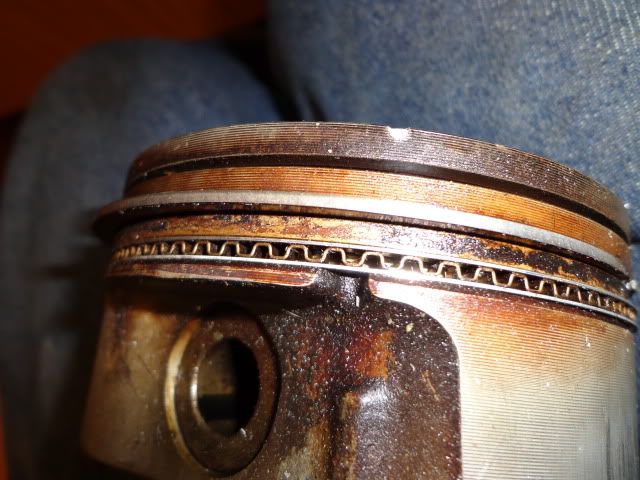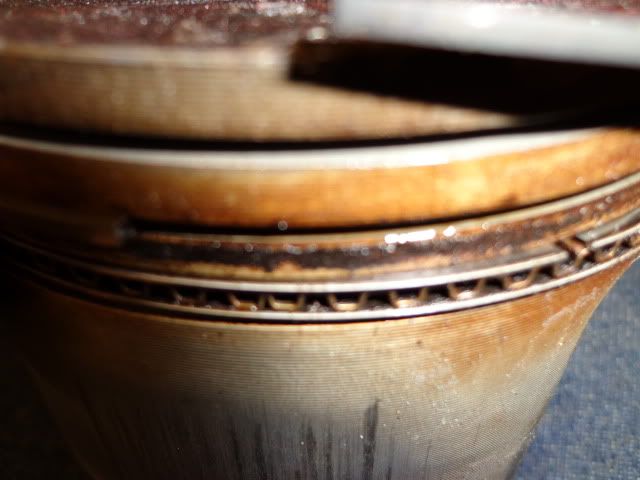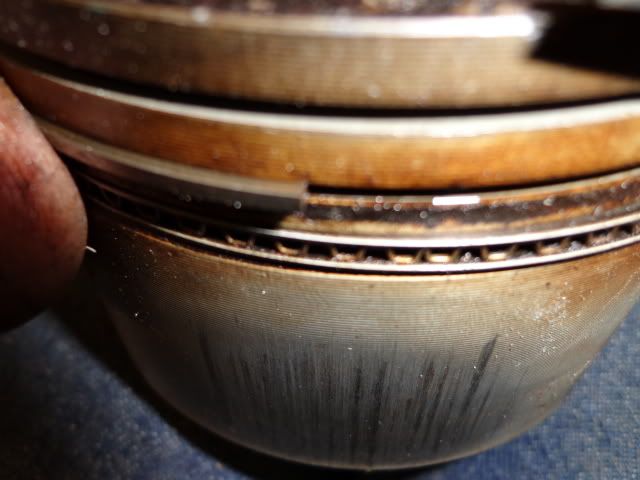You are browsing camaro5 

 |
|
|
#43 |
       Drives: 2012 LS M6, Black Join Date: May 2009
Location: Phoenix, AZ
Posts: 2,045
|
I did a lot of near full throttle runs up to around 70-80, then took it out of gear and coasted/bedded brakes. I heat cycled the engine. I varied gears/rpm's and speeds.
I ignored the "easy" part. John B.
__________________
 12 LS M6, IPF S/C, ASA GT-5 wheels, VMax PTB 12 LS M6, IPF S/C, ASA GT-5 wheels, VMax PTB1995 Mitsubishi Montero SR 1987 Dodge Raider Turbo Project 1986 Mitsubishi Montero 2.4l FI Transplant |
|
|

|
|
|
#44 |
|
Account Suspended
Drives: 2012 Camaro RS, RX supercharged Join Date: Dec 2009
Location: Bradenton, FL
Posts: 6,063
|
We break our race engines in like this (and they go 250-300 or more runs a season)
After assy and intial head torque and valve lash (.800 above cam lift) we fill w/conventional Valvoline racing oil or Joe Gibbs or Brad Penn, start and bring to temp.....check for leaks, obvious noise, etc. Then shut down, retorque head studs, check valve lash then to the track. Do one 1/2 track run (1/8th mile) come back check for leaks, loose bolts, etc. and valve lash just to see if anything is "going away". If all is well, we do a full pass....come back (remember, these are 6 second alky motors costing $25k and up and we DO care about them lasting....we dont continue to win divisional, National, and World championships with motors not lasting or not broken in properly) check everything one more time, one more valve lash (this is the telling part about internals in the valvetrain being all in good shape) then we do one more full pass, drain the break in oil, fill w/full syn (we run much bigger tolerances due to the 8k RPM's so we run a 15/50...do NOT run a street motor with that weight) and we go racing. Rings are seated, all is good. As for the street motors I qualified my post that those that want to follow the legal/marketing/budget written reccomendations please ignore the correct way. And yes, I have been building engines for over 38 years..have done probably thousands, tear down the LS motors every week and see the effects of different oils & maintanance and break-in procedures. This has been proven over and over and Darin Morgan is one of the most interviewed and quoted engine builders in the industry (along with Tony Mamo, etc.) and we all see this and I guarantee that if the engineers at GM could speak freely (they are not allowed to make any public comments not pre approved for release and several we talk to on a regular basis sharing data and ideas...we learn and they learn) they would verify all of this. The brakes are broken in after 2 bedding stops....the trans needs no breakin (auto), and manual very little. Rear gears (ring & pinion) do take a bit...we use conventional gear lube and then swap to full syn. If we break them in w/full syn we find "hot spots" as they dont mesh as well in the wear-in process. Could you imagine how sales would move to another manufacturer if they did tell you to run break in oil for 500 miles, drive hard, and then have to come back in for a change to syn in 500 miles? Marketing....thats why the LLT & LFX are advertised to run on 87 octaine, yet at 11.3:1 CR they make more power and run better on 93? Todays car buyer wants to have the least maintanance possible. Cheapest gas, and just drive. Think about it...how in the world can rings seat properly in the short 400-500 mile window before the cylinder walls form the hard glaze when running an oil that is SO superior in protection these motors go 1/2 million miles if cared for with? Especially if the motor is babied? It is very important to vary RPM's and to let it cool and heat cycle a few times before wide open throttle so the valve springs gain optimine strength, etc. but the #1 warranty related complaint at GM is "excess oil consumption" and the fix? tear down, rehone cylinder glaze off, and replace rings that did not seat properly. And in the old days you would never tolerate 1-1.5 qt usage per 1000 miles....yet GM (and most other auto manufacturers) states it is "within accepatable guidelines". If what the masses believed was true none of us aftermarket manufacturers would be in business and you would not see so many of the performance industries ideas incorporated into new car/engine designs. So again....I didnt make the post for the koolaide drinking masses (dont be offended, 99.9% of car owners fall into this group) but for the few that want to keep their car for the duration and to avoid the issues so many complain about. I gain nothing sharing this knowledge.....and it takes time I could be billing out in the shop to post these informational contributions and I am not looking for a fight.....you pay the $ for your car, treat it as you think is best. 
|
|
|

|
|
|
#45 | |
|
MIC
Drives: 2012 SSRS 6sp man Blk Join Date: Nov 2009
Location: Central FL
Posts: 383
|
Quote:
Do you think Nascar or drag companies break in the drive train, brakes, engine for 1,500 miles? It depends on what you want. My first new car was a 1966 L79 Chevy II. I drove it from the dealership to I70 which was about 40 miles and then I cranked it up to about 80 4 or 5 times letting it coast in neutral and then did it again. Still doing it with new cars. Listen to Tracy or do what the manual says. It depends on what you want. |
|
|
|

|
|
|
#46 |
|
Account Suspended
Drives: 2012 Camaro RS, RX supercharged Join Date: Dec 2009
Location: Bradenton, FL
Posts: 6,063
|
fz4 also added some very good info in post #36.

|
|
|

|
|
|
#47 |
|
Account Suspended
Drives: 2012 Camaro RS, RX supercharged Join Date: Dec 2009
Location: Bradenton, FL
Posts: 6,063
|
Also, these motors have all come with Mobile 1 full sysn from the factory and the rings cannot in most cases wear in or seat properly in the short 4-500 mile window so chances are if you have excess consumption after 5-10 k miles only new rings and cylinder honing will cure this, but the catchcans at least trap this and prevent what you see below.
Here are some pics of a LS1 piston run w/out a catch can for app 120k miles. And as you can see I surmise more conventional oil was used instead of full synthetic. looking at the varnish below the rings, but the problems causing oil comsumption on this motor. Look at the gunk/residue that formed in the ringlands and this casues the rings to not be able to move freely in the grooves....allowing blowby and oil usage past the rings:    You will also notice the score marks on the piston skirt. This is caused by the hard carbon particles that break loose and get trapped between the piston and cylinder walls. Now of course, this motor had a neglected 120k miles so this is worse than most....but using a upper induction cleaning to loosen deposits is good and bad as some of the hard carbon particles that are loosend from the intake valves and piston tops does get forced past the rings and carbon is extremely hard and abrasive. The LS1 (and rest of the LS family) are port injection motors so using a top tier furl (shellm mobile, etc.) with "gunk reducing additives" helps keep the deposits from forming and they do a great job.....but our direct injection motors have no fuel traveling past the intake valves so the oil ingestion a proper catchcan prevents (and by proper, very few catch all or nearly all the oil....most only catch a portion. The Elite, AMW, Saiku Micchi, and Mike Norris are amoung the best, and of course the RX can) so this oil bakes onto the intake valves causing the exccesive build up and in as little as 8-10-12k miles look worse than a port inj engine with 100k miles. Now look at these pictures closely. See the area of the piston above the compression (top) ring? That is where most of the deposits/gunk form and this is what causes the rings to begin to stick and not seal properly. Then below between the scraper ring you see far less, then the oil ring below that provides the lubrication between the piston and the cylinder wall. Now all of this occurs over time gradually and most trade their car/truck in before most is noticed....but all motors today are moving to the far superior direct injection so these issues have been extremely accelerated and adding a proper functioning catchcan at new prevents all or nearly all of this from occuring. This is just the physical side of oil ingestion....the immediate I have covered in many threads (poor fuel economy, power loss, etc.). 
|
|
|

|
|
|
#48 | |
 Drives: 2010 GT500 Join Date: May 2013
Location: Florida
Posts: 64
|
Quote:
|
|
|
|

|
|
|
#49 |
|
Dean Voss
|
I installed 3.91 rear gears with sae85-140 oil When I change the oil what should I use when I must change it ? I have no noises in the rear. I was told to change to a synthetic oil, but what grade oil?
|
|
|

|
|
|
#50 | |
           Drives: 2017 2SS M6 Join Date: Jun 2013
Location: WNY
Posts: 7,070
|
Quote:
GM tells you to take it easy because they dont want some idiot to get in a accident braking it in properly.
__________________
real ZL1 wheels and brakes, 285/305 Michelin Pilot Super Sports, Pray ported Intake manifold, Soler Throttle Body, Rotofab intake, EFI Tuning Flex fuel kit, full American Racing Headers Exhaust, 1 7/8" w/ cats H pipe and mufflers. Full 1LE suspension, with BMR adjustable sway bars and links, GM aluminum cradle bushings, Hurst shifter with lighter reverse spring, TWM shifter knob, Tick level 1 transmission. I should have bought a ZL1
|
|
|
|

|
|
|
|
|
 |
| Tags |
| breaking, fast, miles, motor |
|
|